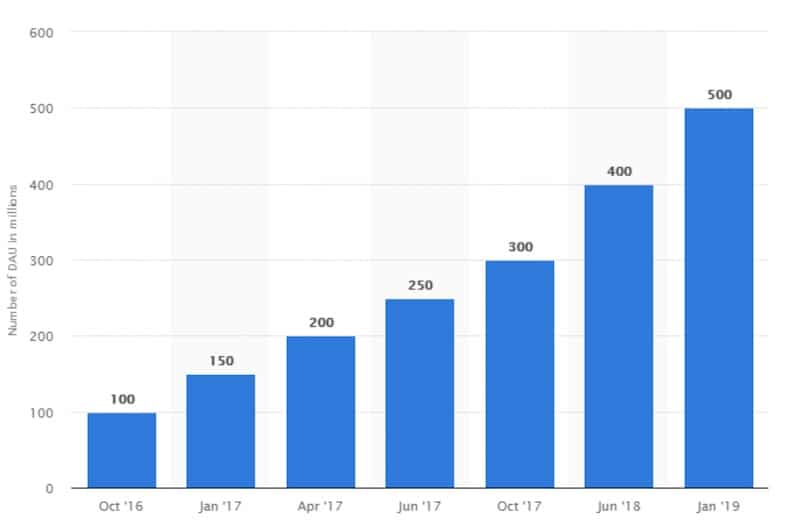The word “storytelling” conjures up a lot of different images for people – probably the least of which is an advertisement. But, as video ads have moved from something you watched on TV to things you hold in your hand, great storytelling can make an online ad stand out from all the others.
Marketers who master storytelling as part of their marketing reap the benefits. The ones who do it not-so-well? They’re getting left further and further behind every week.
All the focus on video as a message delivery system can sometimes take over an equally important conversation: the ad experiences that utilize them. Video on its own is a compelling storyteller, but the formats of ads in paid social aren’t lather, rinse, repeat. As with most things, what used to be a simple video ad unit in a feed somewhere has spawned new iterations of ads. These formats are the ones poised to take us into the next phase of how video is consumed by users – but are you ready for it?
Social Story Sand-Shifting
One of the things making paid social infinitely more complex by the month are the myriad ad types that are added – and by types, we don’t just mean image vs. video. We mean the very way in which users experience them and interact with them.
One of the fast-emerging darlings that we love are Instagram Stories.
First rolled out as an organic offering, Instagram Stories became an ad placement as adoption of the unit grew amongst mobile Instagram users. It’s quickly paved the way for vision around what the future of ads is going to be, and is proving a worthy challenge for advertisers who have been stuck in a “catch-them-with-a-compelling image-in-their-feed” mindset for too long.
Unlike a feed that a user scrolls through, a Story is a full-screen experience, showing an image or video. Instead of clicking on anything, a user can swipe up to go to a URL, or open an Instant Experience if an ecommerce brand sets it up to do so.
The experience is truly immersive. Sure, you can tap on it to skip it, but sliding on by doesn’t feel as much a habit yet as it does for something like a feed where your eyes are scanning for the next thing. There isn’t a “next thing” in Stories – you don’t really know what will pop up next. BAM! The user is still in your story for the duration!
Users can skip to the next Story by swiping right, and the ad lasts a maximum of 15 seconds. As a user, you experience a Story ad sandwiched between organic Stories that are posted by friends. This is partially what makes them super-interesting. We engage the audience while they are immersed in stuff they’re already interested in.
For awhile, advertisers could accomplish that in the feeds with Facebook, and in quite a few instances it can still work. However, there are usually “tells” that something is an ad in the feed, usually most noticeable with the presence of a call-to-action button. Stories help eliminate some of the “ad” feel, making it a great spot for brands to focus on one-on-one, audience-connecting communication.
Story Ads also tipped their hat for likely future bells and whistles by later rolling out the ability to include polls that users can interact with – something that first existed in the organic Story placement for Instagram users.
This interactive, crowd-sourcing avenue is exactly where we foresee ads continuing to go in the future. Presenting the information and soliciting user input is a far more impactful way to engage with people and cement a brand in a user’s mind versus relying solely on flashing ads at them many times, no?
Why We’re Big On This Small Screen Phenom
Snapchat has a similar creative experience for Story ads, lest this sound like a single-platform experience; it isn’t. We will undoubtedly see this format continue to be adopted by other paid social platforms, even if they don’t have it as an organic placement version currently. It’s a growth pattern that can’t be ignored.
And advertisers are noticing, quickly.
Facebook’s conversions didn’t even come from the feed placements.
While Instagram’s feed is still dominating for results, Stories is doing it for a comparable CPA and certainly for better than anything Facebook is producing. This is an example of where we usually break Stories into its own ad set and allocate a budget to max out that placement and see how high we can drive volume.
The phenomenon of seeing Stories outperform Facebook isn’t unusual for us. Here is another example. Again, we aren’t necessarily comparing Stories to the Instagram Feed, but rather as an alternative place to move Facebook money:
In this case, it’s a higher-volume advertiser where we deliberately created separate campaigns for Instagram Stories. When we took over this account, we noticed patterns similar to the other client noted here: Stories had a strong initial result, but it wasn’t getting as much of the budget. We set them up as a separate campaign placement with its own budget. It scaled well and far outperformed Facebook – the biggest limitation still in most cases is the inventory available.
So imagine our glee when it was announced just last month that Instagram is increasing inventory specifically for the Stories placement.
OK, what are the hard parts of Instagram Story Ads?
Being Instagram, we are still subject to less inventory. So if it’s rockin’ the house for you, eventually you’ll probably find a spend limit you can’t surpass. Bummer. This should continue to get better, based on the growth rate of daily active user growth historically:
Other challenges can become evident depending on the demographics you are trying to reach. Per Statista, as of April of 2019, two-thirds of the Instagram audience is under the age of 34. That’s not to say you won’t have success in ages beyond that, but you are likely to feel that limited inventory issue more so than other brands that target a younger audience.
If we’ve made this all sound otherwise super-simple, there is one potentially huge roadblock to success: our creative.
Once for more the folks in back: without strong creative, tailored for this placement type, the odds of slamming great results are teensy-weensy.
Stories are a different format and experience than ANYTHING that runs as a normal feed ad. Many brands don’t treat them this way; they automatically run the Facebook creative and are stunned when the results don’t match what they read about. This is one of the key places where we see brands fail.
Ready for the next steps?
- Things to Make Instagram Story Add Sing – Find out the easily-missed reasons your Instagram Stories might be failing, and how to turn that around!
- Your Stories Made Epic – Learn how the new templates built into the Facebook/Instagram ad interface make Story Ad creating a breeze.















